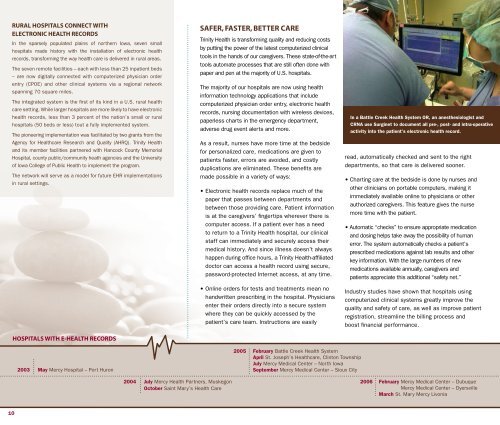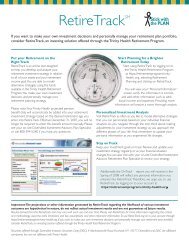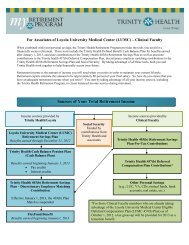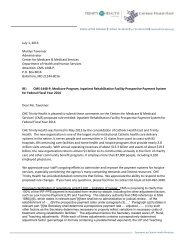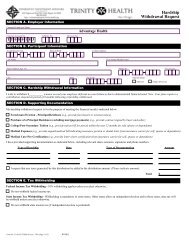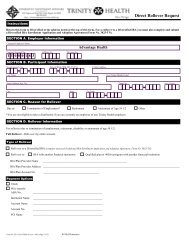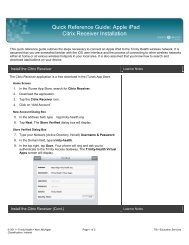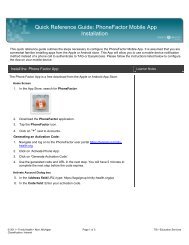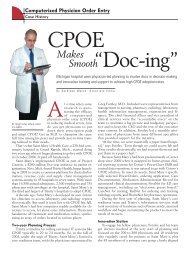Trinity Health Annual Report 2008
Trinity Health Annual Report 2008
Trinity Health Annual Report 2008
You also want an ePaper? Increase the reach of your titles
YUMPU automatically turns print PDFs into web optimized ePapers that Google loves.
Rural Hospitals Connect with<br />
Electronic <strong>Health</strong> Records<br />
In the sparsely populated plains of northern Iowa, seven small<br />
hospitals made history with the installation of electronic health<br />
records, transforming the way health care is delivered in rural areas.<br />
The seven remote facilities – each with less than 25 inpatient beds<br />
– are now digitally connected with computerized physician order<br />
entry (CPOE) and other clinical systems via a regional network<br />
spanning 70 square miles.<br />
The integrated system is the first of its kind in a U.S. rural health<br />
care setting. While larger hospitals are more likely to have electronic<br />
health records, less than 3 percent of the nation’s small or rural<br />
hospitals (50 beds or less) tout a fully implemented system.<br />
The pioneering implementation was facilitated by two grants from the<br />
Agency for <strong>Health</strong>care Research and Quality (AHRQ). <strong>Trinity</strong> <strong>Health</strong><br />
and its member facilities partnered with Hancock County Memorial<br />
Hospital, county public/community heath agencies and the University<br />
of Iowa College of Public <strong>Health</strong> to implement the program.<br />
The network will serve as a model for future EHR implementations<br />
in rural settings.<br />
Hospitals With e-<strong>Health</strong> Records<br />
Safer, Faster, Better Care<br />
<strong>Trinity</strong> <strong>Health</strong> is transforming quality and reducing costs<br />
by putting the power of the latest computerized clinical<br />
tools in the hands of our caregivers. These state-of-the-art<br />
tools automate processes that are still often done with<br />
paper and pen at the majority of U.S. hospitals.<br />
The majority of our hospitals are now using health<br />
information technology applications that include<br />
computerized physician order entry, electronic health<br />
records, nursing documentation with wireless devices,<br />
paperless charts in the emergency department,<br />
adverse drug event alerts and more.<br />
As a result, nurses have more time at the bedside<br />
for personalized care, medications are given to<br />
patients faster, errors are avoided, and costly<br />
duplications are eliminated. These benefits are<br />
made possible in a variety of ways:<br />
• Electronic health records replace much of the<br />
paper that passes between departments and<br />
between those providing care. Patient information<br />
is at the caregivers’ fingertips wherever there is<br />
computer access. If a patient ever has a need<br />
to return to a <strong>Trinity</strong> <strong>Health</strong> hospital, our clinical<br />
staff can immediately and securely access their<br />
medical history. And since illness doesn’t always<br />
happen during office hours, a <strong>Trinity</strong> <strong>Health</strong>-affiliated<br />
doctor can access a health record using secure,<br />
password-protected Internet access, at any time.<br />
• Online orders for tests and treatments mean no<br />
handwritten prescribing in the hospital. Physicians<br />
enter their orders directly into a secure system<br />
where they can be quickly accessed by the<br />
patient’s care team. Instructions are easily<br />
In a Battle Creek <strong>Health</strong> System OR, an anesthesiologist and<br />
CRNA use Surginet to document all pre-, post- and intra-operative<br />
activity into the patient’s electronic health record.<br />
read, automatically checked and sent to the right<br />
departments, so that care is delivered sooner.<br />
• Charting care at the bedside is done by nurses and<br />
other clinicians on portable computers, making it<br />
immediately available online to physicians or other<br />
authorized caregivers. This feature gives the nurse<br />
more time with the patient.<br />
• Automatic “checks” to ensure appropriate medication<br />
and dosing helps take away the possibility of human<br />
error. The system automatically checks a patient’s<br />
prescribed medications against lab results and other<br />
key information. With the large numbers of new<br />
medications available annually, caregivers and<br />
patients appreciate this additional “safety net.”<br />
Industry studies have shown that hospitals using<br />
computerized clinical systems greatly improve the<br />
quality and safety of care, as well as improve patient<br />
registration, streamline the billing process and<br />
boost financial performance.<br />
2003 May Mercy Hospital – Port Huron<br />
2005 February Battle Creek <strong>Health</strong> System<br />
April St. Joseph’s <strong>Health</strong>care, Clinton Township<br />
July Mercy Medical Center – North Iowa<br />
September Mercy Medical Center – Sioux City<br />
2004 July Mercy <strong>Health</strong> Partners, Muskegon<br />
October Saint Mary’s <strong>Health</strong> Care<br />
2006 February Mercy Medical Center – Dubuque<br />
Mercy Medical Center – Dyersville<br />
March St. Mary Mercy Livonia<br />
10


